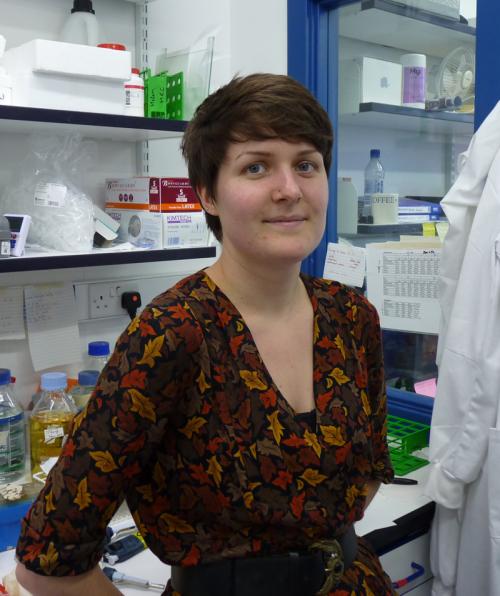
Helen publishes first biochemical analysis of PINK1
Mutations in PINK1 were discovered in 2004 in patients suffering from familial Parkinson's disease. PINK1 is an unusual protein kinase containing a mitochondrial targeting domain and 3 insertions within its kinase domain. Despite intensive research little was known about the catalytic properties of PINK1 since the human form of the enzyme displayed very little activity. In Drosophila melanogaster, loss of PINK1 function produces a striking phenotype comprising both flight muscle and brain degeneration although the mechanism for this is unknown. This phenotype can be rescued by re-expression of the wild-type but not kinase-inactive version of PINK1 suggesting that the kinase activity of PINK1 is central to its function.
Helen Woodroof, a PhD student in the MRC Protein Phosphorylation Unit, decided to express and test PINK1 from Drosophila melanogaster (dPINK1) and the related insects species, Tribolium castaneum (TcPINK1), and Pediculus humanus corporis (PhcPINK1). She discovered that in contrast to mammalian PINK1, these insect species were active as judged by their ability to phosphorylate the generic substrate myelin basic protein. This was the first time that anyone had been able to measure PINK1 kinase activity directly. Using the most active enzyme (TcPINK1), she undertook a domain analysis and found that the C-terminus was essential for PINK1 activity. In collaboration with Alex Whitworth's lab in Sheffield, she was also able to confirm that TcPINK1 (and PhcPINK1) were true PINK1 orthologues since they could rescue the Drosophila PINK1 null phenotype.
Next in collaboration with Mike Begley and Lew Cantley at Harvard, an optimal peptide substrate for PINK1, was determined from a positional scanning library screen, which was KKWIpYRRSPRRR and designated PINKtide. Helen studied variants of PINKtide and established that the +1 proline was crucial for PINKtide phosphorylation.
An important and outstanding question in the PINK1 field has been how disease-causing mutations affect PINK1 function. Helen was able to model seventeen conserved missense and truncating human mutations in TcPINK1 including W437X, which was the first mutation, described in a PINK1-affected family (Marsala kindred) and tested their activity against PINKtide. Helen found that nearly all disease-causing mutations of PINK1 confer their effect by inactivating PINK1.
Helen's findings demonstrate that PINK1 kinase activity is crucial for preventing the onset of Parkinson's disease. The next major challenge in the field is to identify physiological substrates of PINK1. Helen's discovery of active PINK1 should aid in this search
Woodroof HI, Pogson JI, Begley M, Cantley LC, Deak M, Campbell DG, van Aalten DMF, Whitworth AJ, Alessi DR, Muqit MMK. Discovery of catalytically active orthologues of the Parkinson's disease kinase PINK1: analysis of substrate specificity and impact of mutations. Open Biol 2011 1, 110012
Helen Woodroof, a PhD student in the MRC Protein Phosphorylation Unit, decided to express and test PINK1 from Drosophila melanogaster (dPINK1) and the related insects species, Tribolium castaneum (TcPINK1), and Pediculus humanus corporis (PhcPINK1). She discovered that in contrast to mammalian PINK1, these insect species were active as judged by their ability to phosphorylate the generic substrate myelin basic protein. This was the first time that anyone had been able to measure PINK1 kinase activity directly. Using the most active enzyme (TcPINK1), she undertook a domain analysis and found that the C-terminus was essential for PINK1 activity. In collaboration with Alex Whitworth's lab in Sheffield, she was also able to confirm that TcPINK1 (and PhcPINK1) were true PINK1 orthologues since they could rescue the Drosophila PINK1 null phenotype.
Next in collaboration with Mike Begley and Lew Cantley at Harvard, an optimal peptide substrate for PINK1, was determined from a positional scanning library screen, which was KKWIpYRRSPRRR and designated PINKtide. Helen studied variants of PINKtide and established that the +1 proline was crucial for PINKtide phosphorylation.
An important and outstanding question in the PINK1 field has been how disease-causing mutations affect PINK1 function. Helen was able to model seventeen conserved missense and truncating human mutations in TcPINK1 including W437X, which was the first mutation, described in a PINK1-affected family (Marsala kindred) and tested their activity against PINKtide. Helen found that nearly all disease-causing mutations of PINK1 confer their effect by inactivating PINK1.
Helen's findings demonstrate that PINK1 kinase activity is crucial for preventing the onset of Parkinson's disease. The next major challenge in the field is to identify physiological substrates of PINK1. Helen's discovery of active PINK1 should aid in this search
Woodroof HI, Pogson JI, Begley M, Cantley LC, Deak M, Campbell DG, van Aalten DMF, Whitworth AJ, Alessi DR, Muqit MMK. Discovery of catalytically active orthologues of the Parkinson's disease kinase PINK1: analysis of substrate specificity and impact of mutations. Open Biol 2011 1, 110012

